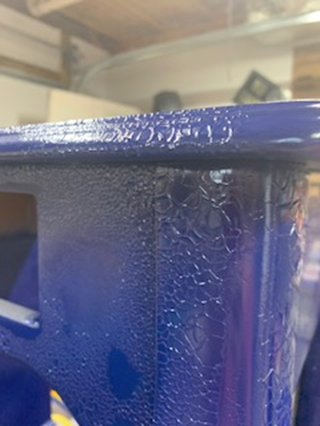I don't believe alcohol is the problem. I have a ticket in with rustoleum to get their advice.
Wrinkling
Wrinkling
An uncommon coating defect, appearing as a raised and crinkled surface, forming after a new coat or coating is applied over a previous one.
Wrinkling may appear after a few minutes, or even as the next coat is being applied. With solvent-based spray paints, wrinkling is typically caused by the solvents in the most recent coat breaking through the "skin" of the previous coat that is still drying.
Causes of Wrinkling:
Applying the next coat too soon
While a rare occurrence, wrinkling may occur with any type of coating, and is usually caused by the timing between two coats or coatings. Once a coat has been applied, it quickly begins to form a skin, and recoating or applying the next coating too soon may cause wrinkling. On Rust-Oleum paint labels there will be drying and recoat times listed, and it is important to read and follow these carefully to ensure a successful application
Applying heavy coats
Applying heavy coats of paint can slow the drying process, leaving the coating vulnerable to wrinkling, as well as other issues such as
mud cracking, and orange peel. For the best results and drying, apply thin, even coats, building the coating thickness over multiple applications
Painting in poor drying conditions
Stated drying times are generally based on a 70°F temperature and 50% humidity. High temperatures (especially direct sunlight) may cause a coating to form a skin too rapidly, which contracts the paint on its surface. Applying in cooler conditions, or high humidity, may slow the drying process considerably. Learn more about drying and curing
here
Sanding just before applying the next coat
Oil-based paint dries through oxidation, or a reaction with air. This causes our spray paints to create a "skin" and sanding can compromise this skin, leaving the drying paint beneath exposed to the solvents in the next coat. If the coating is sanded, it is best to clean away the sanding debris, and allow the skin to harden for 24-48 hours before continuing on with the next coat
Surface contaminants (wax, grease, etc.)
Proper surface preparation prior to painting is the key to a successful application, and the best way to ensure a defect free, perfect finish every time. Use of a quality degreaser such as our
Krud Kutter Original is an excellent way to ensure all surface contaminants are removed, and the priming coat will strongly adhere to the substrate. While surface contaminants may cause film defects on the first coat, such as
fisheyes, dust and debris may also settle on an existing coat, causing problems when the next coat is applied. Wiping the surface clean prior to applying the next coat is good practice if there has been an extended time between coats
Fixing the surface:
- First, lightly sand the wrinkled portion of the surface with 220-320 grit sandpaper until it is smooth. A sharp paint scraper may also be used to scrape just the wrinkled portion smooth and flush with the surrounding paint. Be sure to clean away all sanding debris from the surface
- Once the surface is smooth, it is best to wait 24-48 hours before recoating, then apply a light, even coat to the entire portion of the project surface that was affected, to ensure an even color and sheen
Always remember that our Rust-Oleum Product Support Team is
here and happy to help if you have any questions or concerns!





 (which is more than I can say for my experiences with spray cans, unfortunately).
(which is more than I can say for my experiences with spray cans, unfortunately).






